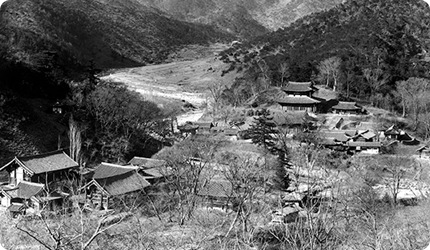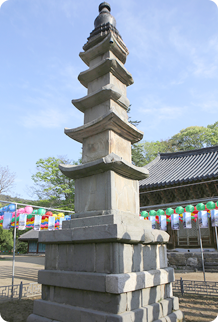Buddhist Mountain Monasteries in Korea
Magoksa Temple
Magoksa Temple
Introduction
Natural Environment
History
Temple Layout
Cultural Properties
Information
History of Magoksa Temple
-
- Records relevant to Magoksa Temple include Taehwasan-Magoksa-sajeok-iban published in the 19th century and Seongyoyangjong-Daebonsan-Magoksa-yeongiryakcho, the year of publication and author of which are unknown.
According to the former, Magoksa was the third temple out of the 7 temples established by Precepts Master Jajang, under the patronage of Queen Seondeok, following his return from the Tang Dynasty. It also states that the temple had been repaired five times between its establishment and the Joseon Dynasty. In contrast, the latter historic document states that Magoksa was founded by National Preceptor and Seon Master Chejing and was later extended and repaired by Beomil and Doseon.
-
 Magoksa Temple during the Japanese occupation period
Magoksa Temple during the Japanese occupation period
- Taehwasan-Magoksa-sajeok-iban mentions that National Preceptor Buril defended Magoksa against plunderers and performed repair work, as instructed by the king, in 1199. It also contains records of the names of some 30 buildings that were erected between the late 12th and late 15th centuries. These records show that Magoksa Temple flourished between the late Goryeo and early Joseon dynasties, and that the basic layout of the temple, which is presently comprised of northern and southern sections, was formulated around this time. The five-story stone pagoda situated in front of Daegwangbojeon that was built in the late Goryeo Dynasty shows influences from Lamaism, and this also shows that Magoksa enjoyed its heyday at the time.
- Records relevant to Magoksa Temple include Taehwasan-Magoksa-sajeok-iban published in the 19th century and Seongyoyangjong-Daebonsan-Magoksa-yeongiryakcho, the year of publication and author of which are unknown.
-
-
 Five-Story Stone Pagoda of Magoksa
Five-Story Stone Pagoda of Magoksa
- Also, according to Taehwasan-Magoksa-sajeok-iban, King Sejo of Joseon visited Magoksa Temple, and praised it as “land that will not fall for 10,000 years.” He also bestowed a plaque for Yeongsanjeon and a handwritten tablet that exempted the monks from miscellaneous compulsory services. Based on this, it can be inferred that Magoksa maintained its prestige and revered status during the Goryeo Dynasty.
However, as a result of the Japanese invasions of Korea in 1592 and 1597, the temple fell into ruins, similar to other temples, and rebuilding work was initiated by Monk Gaksun in 1650.
The records regarding the events occurring after the restoration work are considerably specific and factual compared to the preceding records.
With the donations from Yi Tae-yeon, the then-head of Gongju-mok, Gaksun conducted a large-scale restoration project over the course of 10 years.
Later, about 1,050 structural compartments including the Dharma halls were destroyed in a massive fire in 1782 (6th year of King Jeongjo’s rule), and rebuilding work was initiated by Hwaju (Lord of Conversion) Chegyu. Of particular note, thanks to Chegyu’s prayers, the king’s first son was born in 1790 (14th year of King Jeongjo’s reign), and Magoksa began receiving the patronage of the Joseon royal family, through which they were able to rebuild the structures on an ongoing manner, and perform its services to the Buddha. Many of the buildings continued to be reconstructed and remodeled, even in the 19th and 20th centuries.
-
Chronological Table
| Time Period | Description |
|---|---|
| 643 | Magoksa Temple is founded by Precepts Master Jajang |
| 1199 | National Preceptor Buril defends the temple against plunders and rebuilds the temple as per the royal orders |
| 1650 | Gaksun performs rebuilding work and establishes a meditation hall and Yaksajeon |
| 1682 | Yeongsajeon is erected |
| 1782 | 1,050 spaces including Daebeopdang are destroyed |
| 1785 | Daegwangbojeon is rebuilt |
| 1791 | Nahanjeon is rebuilt |
| 1795 | Placent Chamber is enshrined, and the Head Temple of Province Seal is given |
| 1844 | Heungseongnu repaired |
| 1846 | Haetalmun is repaired |
| 1879 | Daeungjeon’s sign is created |
| 1910 | Haetalmun and Cheonwangmun are repaired |
| 1923 | Daeungjeon is repaired |
| 1939 | Myeongbujeon is founded |
